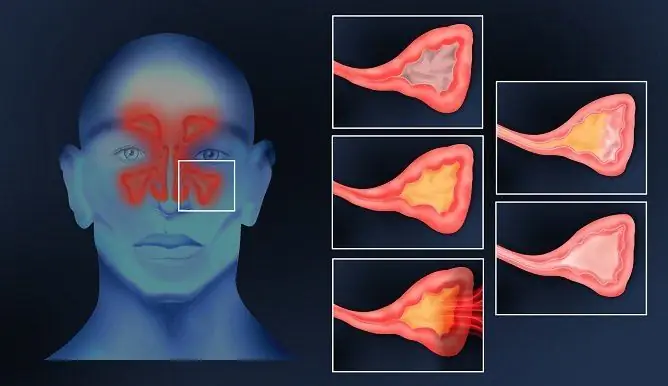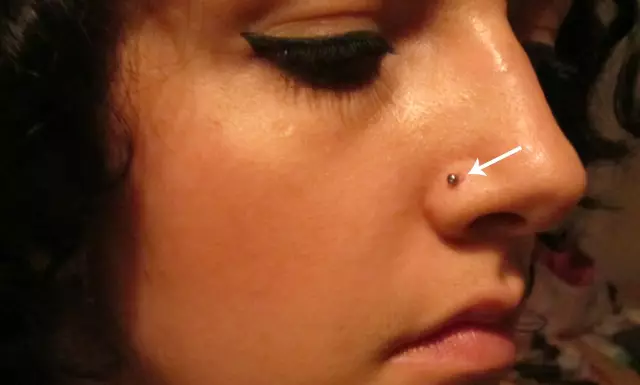- Author Rachel Wainwright [email protected].
- Public 2023-12-15 07:39.
- Last modified 2025-11-02 20:14.
How to rinse your nose with sinusitis at home
The content of the article:
- How to properly rinse your nose with sinusitis
-
Means for rinsing the nose with sinusitis
- Antiseptics
- Saline solutions
- Herbal decoctions
- Video
Sinusitis (maxillary sinusitis) is an inflammation that occurs in the maxillary paranasal sinus. Its development is mainly caused by infection - viruses or bacteria enter the maxillary sinus through the blood, the nasal cavity or through pathological processes in the periapical areas of the upper teeth.

One of the most effective methods of treating sinusitis at home is rinsing the nasal cavity.
Diagnosis of inflammation is carried out by physical examination and collection of anamnesis of the disease. One of the main symptoms indicating the presence of sinusitis is a pulling pain that occurs when the head is tilted forward.
It is better to start therapy in the early stages of the disease, since the inflammatory process can spread to the ears and throat and provoke the development of recurrent tonsillitis, pharyngitis and otitis media. For treatment, antibiotics of a wide spectrum of action, vasoconstrictors, antihistamines (if sinusitis is caused by allergies), as well as nasal rinsing, carried out at home, can be prescribed. The effectiveness of the therapy used is determined by the reduction of the inflammatory process, the removal of edema and the restoration of the drainage function of the opening connecting the maxillary sinus with the middle nasal passage.
In case of untimely therapy of inflammation, if it is still possible to avoid a sinus puncture, the patient is hospitalized, and the otolaryngologist (ENT) performs the nasal lavage.
How to properly rinse your nose with sinusitis
It is recommended to start rinsing the nasal cavity as early as possible after the first signs of inflammation and diagnosis are made. It is better to check with your doctor about how many times a day to carry out the procedure. Thanks to washing from the paranasal sinuses, serous-purulent exudate is removed, inflammation is relieved and nasal breathing is restored.

A special kettle is required for rinsing the nose
By strictly following the doctor's prescriptions, the negative consequences of maxillary sinusitis can be avoided. To carry out the procedure at home, you must purchase medicines prescribed by a doctor, prepare special solutions. Also, depending on the purpose, you may need: a large syringe, a syringe, a nasal shower or a kettle for rinsing the nose (Dolphin). In the absence of auxiliary equipment, the solution can be drawn in with the nostrils from the palm of your hand.
As solutions for rinsing the nose with sinusitis at home, decoctions of medicinal herbs, anti-inflammatory and antiseptic drugs, saline and alkaline solutions, antibiotics can be used. For the procedure, you can not use too hot or cold means, its ideal temperature varies from 38 to 40 ° C.

The simplest and most effective way to rinse the nasal cavity is by flow. It is performed using a syringe (a syringe without a needle, a nasal shower, or a kettle) in the following sequence. The prepared solution is collected in a large soft syringe.
The patient leans over the sink (basin or bath), turns his head to the side so that the nostril is less congested on top, since the procedure begins with it. The syringe tip is smoothly and deeply inserted into the upper nostril. By gently pressing the syringe, fluid is gradually introduced into one nasal passage so that it flows out of the other. In order to avoid getting the solution into the throat, it is recommended to make lingering vowel sounds.
The procedure is repeated from the second nostril. At the end of the manipulation, the patient alternately blows each nasal passage so that the remnants of purulent-mucous exudate and rinsing solution come out of the sinuses and passages.
After washing, it is recommended to lie down for 40-50 minutes, resting your head on a high (additional) pillow. This precaution is necessary to prevent residual solution from entering the cavity of the Eustachian tube, which can lead to the development of otitis media.
It should be borne in mind that solutions with medicines or sea salt should be prepared immediately before the procedure. It is not recommended to reuse the prepared products.
To achieve a therapeutic effect, the procedure should be repeated 2-3 times a day, and its duration should be 5-15 minutes.
Means for rinsing the nose with sinusitis
Antiseptics
Most often, antiseptic solutions are prescribed for rinsing the nose with maxillary sinusitis.

Furacilin can be prescribed for rinsing the nose with sinusitis.
Furacilin can be used to prevent and treat inflammation. It is active against many gram-negative and gram-positive microorganisms, including staphylococci and streptococci, which most often cause inflammation of the paranasal sinuses.
There are several dosage forms of the drug - alcohol solution, tablets and sterile solution. For rinsing the nose with Furacilin for sinusitis, a sterile solution or tablets are used, since the use of an alcohol form can lead to a serious burn of the nasal mucosa.
When prescribing tablets, the doctor gives recommendations for their dilution. Usually, to prepare a solution, one crushed tablet of 0.2 g is dissolved in 1 liter of boiled water (temperature - 40-42 ° C).
Chlorhexidine can also be prescribed for washing, although its instructions for use do not indicate that the medicine can be used in such cases. For the procedure, a ready-made solution of 0.05% concentration is used.
In the complex therapy of sinusitis, hydrogen peroxide (hydrogen peroxide) can be used, but only as directed by a doctor and in the indicated dosages (in order to avoid burns of the nasal mucosa). For instillation or rinsing of the nasal passages, a 3% solution diluted in boiled water or saline solution is used 4-5 times a day.
For instillation of the nasal passages in adults, 10-12 drops of hydrogen peroxide are mixed with 1 tbsp. spoon of water (30-35 ml). Then 5-6 drops of the resulting solution are instilled into each nostril. After the procedure, the sinus must be cleansed of accumulated mucus. In children, the doctor will adjust the dosage depending on the severity of the symptoms and the age of the child.
To rinse the nose, 30-35 ml of hydrogen peroxide is mixed with 130-150 ml of warm water.
Saline solutions
Salt water rinsing of the nasal passages, according to reviews, is the most common method of treating sinusitis at home. Saline solution saturates the mucous membrane with sodium and chlorine ions, which are responsible for regulating cell function and the distribution of fluid in tissues. The minerals contained in the salt activate the ciliated epithelium and increase local immunity. Salt helps to dissolve and remove mucopurulent exudate from the nasal cavity and reduces inflammation.
The saline solution can be purchased ready-made or prepared by yourself. To do this, 1 teaspoon of table or sea salt is dissolved in 0.5 liters of boiled water at 36-38 ° C. The nasal passages are washed with this agent 2-3 times a day.

For rinsing the nose with sinusitis, saline is often used
Also, baking soda can be used to prepare the solution, which helps to relieve swelling of the nasal mucosa. For this ½ teaspoon of salt is mixed with the same amount of soda and dissolved in 200 ml of boiled water. With a ready-made product, you can both rinse the nasal passages (3-5 times a day) and gargle.
Herbal decoctions
Therapy of maxillary sinusitis involves an integrated approach, therefore, along with medications, herbal decoctions can be used. The selection of herbs, their dosage and duration of therapy should be determined by the doctor, since herbal medicine has a number of contraindications and, if used incorrectly, can harm the patient.

Decoctions of medicinal herbs, in particular St. John's wort, are often used to rinse the nose
It is believed that natural medicines for sinusitis have a milder effect on the nasal mucosa than synthetic drugs, more effectively relieve inflammation and eliminate nasal congestion.
Many herbs contain phytoncides, which are antibacterial, antimicrobial, antiseptic, and anti-inflammatory. Most often, yarrow, chamomile, calendula, St. John's wort, peppermint, fragrant lemon balm and plantain are used to treat sinusitis.
In chronic sinusitis, when purulent discharge does not form, a decoction of St. John's wort is used for washing. For its preparation, 0.2 l of boiling water is poured into 1 tbsp. a spoonful of dry herb, insist for 1 hour, and then carefully filter.
Multicomponent herbal formulations can also be used. To do this, separate decoctions are prepared from chamomile (10 g), St. John's wort (15 g) and marsh creeper (10 g). Ready-made, these decoctions are mixed immediately before the procedure.
With sinusitis, herbal decoctions are also used for inhalation. Solution preparation method: 1 tbsp. a spoonful of peppermint is mixed with the same amount of lemon balm and 2 tbsp. spoons of plantain perforated; the resulting mixture is poured into 0.5 liters of boiling water and infused for 20-30 minutes, after which it is brought to a boil. Immediately before the procedure, eucalyptus essential oil (2 drops) is added to the infusion. Duration of inhalation should not exceed 5 minutes.
To eliminate the symptoms of inflammation, it is recommended to use aloe juice (in the form of drops). The extract of this plant is included in some medicines used to treat sinusitis. 5 drops of juice of the leaves of an adult plant are instilled into each nasal passage 3 times a day.
It is important to take into account that traditional medicine cannot be the main remedy for the treatment of acute forms of maxillary sinusitis. In cases of increased body temperature, rinsing the nose and inhalation with herbal decoctions are contraindicated.
Video
We offer for viewing a video on the topic of the article.

Anna Kozlova Medical journalist About the author
Education: Rostov State Medical University, specialty "General Medicine".
Found a mistake in the text? Select it and press Ctrl + Enter.






